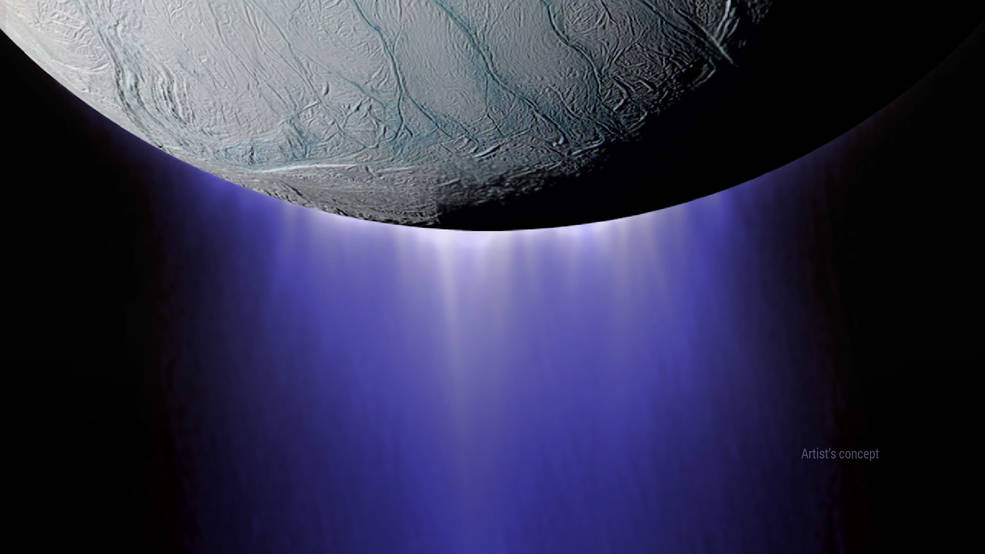
Icy water plumes spray forth from the frozen surface of Enceladus and provoke speculation that life resembling Earth’s psychrophiles may be lurking in a liquid ocean beneath. Credit: NASA/JPL-Caltech (Artist’s concept)
As soon the Earth’s molten mass cooled following the Hadean Era, moon-forming event, and late heavy bombardment, life was present and proliferating in all of its diverse and mysterious glory.1 The oldest rocks are 3.9 billion years old (bya) and radiometric bio-signatures date to earlier than 3.8 bya.2,3 Because life appeared so rapidly and under such hostile conditions, some origin-of-life (OOL) researchers believe that Earth-life may have originated elsewhere and then arrived via meteorite during the fray.4 Perhaps life even initiated independently both on Earth and on other planets or moons. Alternatively, the planet’s earliest life-forms may have lurked in deep places, easily riding out catastrophic conditions raging above on the surface. In order to posit novel naturalistic OOL scenarios, scientists look to some exotic little microbes harbored within some of the world’s most extreme environments.
Extremophiles demonstrate that life can exist in a wide variety of conditions: high temperatures, low temperatures, high pH, low pH, high salinity, or high pressure.5 Life can be found nearly everywhere, so first-life must have been fast and easy, even simple – so it would seem. Because they exhibit some of the smallest genomes of independently living, non-symbiont, non-parasitic organisms, various extremophilic organisms appear to be rooted at the base of the of the evolutionary tree.6,7 Maybe OOL researchers have simply not been looking in the right places. Even so, finding life in any locale is not the same as finding its origin.
Thermophiles and hyperthermophiles are early-life candidates that presumably developed as the mostly molten Earth started to cool. They can withstand temperatures up to 70°C and 113°C, respectively, and may also occur in the high-pressure environments near hydrothermal vents. Research has shown that deep ocean chemistry can produce peptides, amino acids, and other bio-precursor molecules.8 In general, however, most prebiotic molecules are unstable in extreme conditions. OOL-critical RNA has been found to be particularly delicate.9 In addition, the cycling of the ocean through these superheated, underwater vents is physically destructive.10 Though some OOL chemistry might be favored at these sites, it is unlikely that all the necessary reagents would remain viable throughout the necessary sequence of OOL reactions. Even though life is still inadequately characterized and ill-defined, it still seems to be an “all or nothing” proposition for the most part.
It is also important to note that thermophilic biochemistry is not “simple.” Rather, “heat-loving” proteins are customized for the stability in hot environments, and they do not adapt well to mesophilic environments. Special interactions between the proteins’ amino acids stabilize their three-dimensional structure, but these same interactions result in a maladaptive rigidity in mesophilic conditions.11 Furthermore, experimentation seems to indicate that the rRNA of the presumed LUCA would have possessed insufficient guanine and cytosine content to have been a thermophile.12 Stanford University and NASA Ames Research Center have determined that as early Earth cooled, “temperature[s] would have persisted within a thermophilic window for at least 100,000 years but for no more than 10 million years – a time window far shorter for life than that on which natural process life-origin models depend.”13 Just as a gradual formation of thermophilic life-form is difficult to imagine, its transformation into a mesophile seems equally unlikely. It appears that they were created in-place, fully customized from the start, with a low likelihood of relocation to mesophilic conditions.
As thermophiles potentially expand the OOL timeline, psychrophiles theoretically expand the OOL habitable zones out to the icy moons of Saturn and Jupiter.14 Such microbes have been found living comfortably in the Antarctic Ocean at around 4°C.15 Bada and Lazcano have noted that low temperatures stabilize some biomolecules, and that some putatively necessary prebiotic reactions only occur in the laboratory at temperatures near 0°C.16 Since the bio-necessity of liquid water remains, psychophiles find ways to lower the freezing point of water. They utilize concentrations of certain molecules17 or antifreeze proteins to this end. This means that these special accommodations would need to be present during the naturalistic construction of the first psychophile in addition to all the “standard” OOL reactants and chemistry. Otherwise, as water began to freeze, cold denaturation would have arrested the hydrophobic effect that allows membrane aggregation, protein folding, and formation of RNA and DNA replicator molecules.18 We find that the whole organism is more robust that its constituent parts, which makes a purposeless and gradual, step-by-step construction process seem implausible.
Sub-surface life found as far as 3.7 miles deep in the Earth’s crust and has prompted even more OOL speculation. Scientists believe that a deep-biosphere may offer realistic early-Earth conditions for first-life or alternatively provide insight into how OOL scenarios transpired beneath the surfaces of other planets and moons.19 Underground or underwater ecosystems in regions devoid of sunlight are often found to depend on organics trickling down from photosynthetically derived products closer to the surface.20 A few microbial populations are truly isolated from surface organics, however, and can live off of crustal carbon dioxide and hydrogen gas generated as water interfaces with rock at tectonic plate boundaries. This, however, is a rare and finely tuned phenomenon that could not occur where tectonic activity is not present (e.g., Mars). In addition, the deeply localized organics have been biogenically produced by these organisms, leaving the origin of their initial organic precursors a mystery.21 Paul Davies asserts that LUCA likely “lived deep beneath the Earth’s surface, at a temperature well above a hundred degrees Celsius, and probably ate sulfur,” but he also concedes that “it is clear that this little creature was already a sophisticated life form with complex features like coded protein synthesis.”22 Furthermore, deep-Earth organisms typically possess extremely low metabolic rates,23 rendering them incapable of sufficiently rapid replication rates required to promote the fast-paced evolutionary advances required by naturalistic models.
Although the search for a mechanistically initiated origin of life continues, extremophiles seem to have originated in-place, optimized and operational from the start.
Then the LORD answered Job out of the whirlwind and said: “Who is this that darkens counsel by words without knowledge? Dress yourself for action like a man; I will question you and you will answer me. “Where were you when I laid the foundation of the earth? Tell me, if you have understanding…Have you entered into the sea, or walked in the recesses of the deep?…Have you comprehended the expanse of the earth? Declare, if you know all this.” Job 38:1-4,16,18
1 Fazale Rana and Hugh Ross, Origins of Life: Biblical and Evolutionary Models Face Off (Covina, CA: Reasons to Believe, 2014), 175-6.
2 Ibid, 176.
3 Takayuki Tashiro et al., “Early trace of life from 3.95 Ga sedimentary rocks in Labrador, Canada,” Nature 549 (2017): 516-8, http://www.nature.com/nature/journal/v549/n7673/full/nature24019.html.
4 Paul Davies, The Fifth Miracle: The Search of the Origin and Meaning of Life (New York: Simon & Schuster Paperbacks, 2000), 186.
5 Fazale Rana and Hugh Ross, Origins of Life: Biblical and Evolutionary Models Face Off (Covina, CA: Reasons to Believe, 2014), 177.
6 Ibid, 178.
7 Rana, Fazale. “Lesson 9: Assembly Of Life, Part 2.” Lecture Notes, Advanced Origin of Life Seminar, Reasons Institute, 2006 (revised 2017).
8 Fazale Rana and Hugh Ross, Origins of Life: Biblical and Evolutionary Models Face Off (Covina, CA: Reasons to Believe, 2014), 178.
9 Ibid, 182.
10 Ibid, 104-6.
11 Ibid, 181.
12 Ibid, 181-2.
13 Ibid, 181.
14 Ibid, 182.
15Ibid, 177.
16 Ibid, 182.
17 Ibid, 182-3.
18 Ibid, 183.
19 Ibid, 184.
20 Ibid.
21 Ibid, 184-5.
22 Paul Davies, The Fifth Miracle: The Search of the Origin and Meaning of Life (New York: Simon & Schuster Paperbacks, 2000), 186.
23 Fazale Rana and Hugh Ross, Origins of Life: Biblical and Evolutionary Models Face Off (Covina, CA: Reasons to Believe, 2014), 184.
 Origin of life research is generally conducted in two different, but related, ways: “bottom-up” and “top-down.” “Bottom-up” researchers seek a combination of chemical reactions that could have yielded a simple, first life-form on the early Earth. “Top-down” researchers seek to understand the simplest of contemporary life-forms, primarily by ascertaining their minimum genome requirements.
Origin of life research is generally conducted in two different, but related, ways: “bottom-up” and “top-down.” “Bottom-up” researchers seek a combination of chemical reactions that could have yielded a simple, first life-form on the early Earth. “Top-down” researchers seek to understand the simplest of contemporary life-forms, primarily by ascertaining their minimum genome requirements.